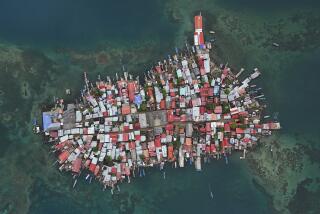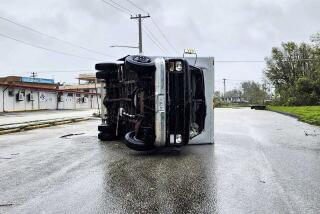Guam Urges U.S. Military to Return Prime Real Estate
- Share via
TAMUNING, Guam — When James Nelson looks at some of Guam’s prime real estate, he dreams of cruise liners packed with well-heeled tourists, cargo ships brimming with tuna, rows of glittering luxury hotels.
He says there’s only one thing in the way: the U.S. military.
“They’ve got so much that we could take advantage of,” said Nelson, general manager of the Guam Visitors Bureau. “There’s a lot of potential for tourism if we had access to those lands.”
More than 50 years after American forces retook this Pacific island from Japanese occupation and turned it into a huge military operation, Guam residents are demanding more of their land back.
The U.S. territory already has built a billion-dollar tourism industry out of its white sand shores, jungle rivers and lush mountains that have made it a haven for free-spending Japanese vacationers.
Now the islanders want more.
The U.S. military controls one-third of Guam’s 212 square miles and is in the process of handing over thousands of acres of land. But Guam’s leaders also have their eyes on military-owned pristine beaches and more top-notch land around the Apra deep-water port.
“The military not only controls one-third of the island of Guam, it also controls the best real estate,” said Rodney Webb, consultant for the Guam Finance Commission. “It’s prime real estate they’re sitting on.”
For the U.S. military, Guam is a top strategic asset. Besides operations providing supply and other support for U.S. Navy forces in the Pacific, there is the sprawling Andersen Air Force Base on the island’s northern end. About 6,900 military men and women are stationed on Guam.
“The Navy is not going away,” said Lt. David Gai, a spokesman for the U.S. military on the island. “Forward deployed forces get what they need from Guam. The strategic importance of Guam is not going away.”
The military says it has already given up more than enough land, and further hand-overs would threaten its defense role in the Pacific--and its role on Guam as a major employer and spender.
“We’re trying to make this a win-win situation with Guam,” Gai said. “If our mission ceases, then the economic impact to Guam would be devastating.”
Guam is not urging the military to leave. But government officials say the island is no longer the bombed-out, impoverished backwater that American servicemen found when they stormed ashore in July 1944.
With the newfound confidence--and cash--that has come from the island growing into a tourism paradise, Guam residents say they need room to expand and diversify their economy.
“We feel we’re the bridge to Asia. We think we can take advantage of it,” said Edward Untalan, head of the Guam Economic Development Authority. “Asia is the market to address in the future.”
Besides beaches, island officials have their eyes mostly on the heavily developed area around Apra Harbor--a key deep-water port between Hawaii and the Philippines--which they hope to turn into a shipping, fishing and warehousing center.
The argument for more land is also emotional. Guam has been under outside control since the Spanish arrived in the 1500s. The Americans took over in 1898 and then again after the wartime Japanese occupation. Islanders say it’s time they took more control over what belongs to them.
The process already has begun. Under a 1995 nationwide base reduction plan, 3,800 acres--including a ship repair station--are being turned over for civilian use.
The naval air station turned over to the local government in 1995 is now Guam International Airport. The military also is giving up two major wharves along one side of Apra Harbor.
The moves are not without a downside for Guam.
The island is already feeling the pinch from cutbacks that have trimmed military personnel on the island from 14,000 four years ago to less than 7,000 and cut the bases’ civilian work force by 30% to 4,500. Unemployment on the island now hovers around 9%.
But island officials hope to turn that around, mainly through the island’s cash cow: tourism. The island attracted 1.4 million visitors in 1996--76% of them Japanese--and the $1.5-billion-a-year industry employs 21,000 people, a commanding 42% of the work force.
The government has big plans. Gov. Carl T.C. Gutierrez’s Vision 2001 program aims to increase the number of hotel rooms from about 7,000 to 12,000 over the next four years and to attract 2 million visitors a year.
Guam’s planners see more than just tourists in their future. They envision the island as a hub for fisheries, cargo shipments through Asia and the Pacific, and even telecommunications and insurance.
“We’re trying to offer different types of opportunities,” Untalan said. “We have a lot of students going off island to get educated but then not returning to Guam.”
More military real estate would come in handy in the effort, officials say.
“You can’t create a business without land,” said Webb, the business consultant.
More to Read
Sign up for Essential California
The most important California stories and recommendations in your inbox every morning.
You may occasionally receive promotional content from the Los Angeles Times.










